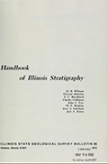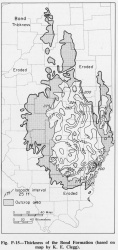Historical:Bond Formation
Lithostratigraphy: McLeansboro Group >>Bond Formation
Chronostratigraphy: Paleozoic Erathem >>Pennsylvanian Subsystem >>Missourian Series
Allostratigraphy: Absaroka Sequence
Authors
M. E. Hopkins and J. A. Simon
Name Origin
The Bond Formation of the McLeansboro Group (Kosanke et al., 1960, p. 39, 50, 70-73) is named for Bond County, where exposures are prominent.
Type Section
Seven separate outcrops in three counties constitute the type section (NE NE NE 3, 10N-2W, Montgomery County; SE NE 28, 12N-1W, Christian County; NE NW SE 7, 8N-2W, Montgomery County; east-central 24, 6N-5W, S 1/2 7, 6N-4W, E edge 6, 7, 6N-4W, and SW NW 29, 7N-4W, Bond County).
Correlation
The formation is also called Bond in Indiana, and it is equivalent to a portion of the Sturgis Formation in western Kentucky.
Extent and Thickness
The Bond Formation varies from less than 150 feet thick in eastern Illinois to over 300 feet in southeastern Illinois and averages about 250 feet (fig. P-15).
Stratigraphic Position
It includes all strata from the base of the Shoal Creek Limestone Member or the La Salle Limestone Member to the top of the Millersville Limestone Member or the Livingston Limestone Member (fig P-2).
Description
The Bond is characterized by a high percentage of limestone and calcareous clays and shales. The limestone members that bound the formation are the thickest and purest limestones in the Pennsylvanian System of Illinois. The upper limestone is as much as 50 feet thick and the lower is in places as much as 30 feet thick. Both are extensively quarried. In southern Illinois, south of the area of prominent development, there is no major single bench of the Millersville, and the equivalent strata are difficult to identify. Red claystones and shales are present in the Bond and are best developed in northern Illinois. Other units of the formation - gray shales, siltstones, and sandstones - are similar to those in the underlying Modesto Formation. Gray shales constitute the greatest portion of the formation, but thick channel sandstones are developed locally.
References
KOSANKE, R. M., J. A. SIMON, H. R. WANLESS, and H. B. WILLMAN, 1960, Classification of the Pennsylvanian strata of Illinois: Illinois State Geological Survey Report of Investigations 214, 84 p.
ISGS Codes
| Stratigraphic Code | Geo Unit Designation |
|---|---|


